This post is apart of a course I am taking for my Librarian diploma *
Part One:In your own or imagined school context, discuss one factor that could foster collaboration and one barrier to collaboration. How could the school community work to overcome the barrier?
As I consider what teacher and student participation in my own school’s context ‘looks like”; the first thing that came to mind was what it sounds like. Our Learning Commons is noisy! There is always talking because there is a lot of collaborating and communicating going on. It is so much different than my experience when I was a kid and I think that is a great thing.
I think one factor that could foster collaboration in our learning commons is the space itself. My learning commons is quite big and has two meeting rooms that are constantly being used by teachers and other professionals in the building. It also has a computer lab and kids from all over the school print from their classroom and come pick up their work from this printer and use the lab as they need it.
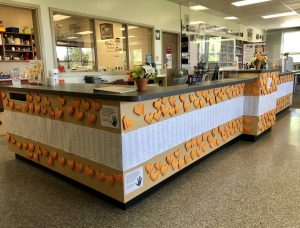
Next to the meeting rooms is a “Green Screen “ room that is used by kids from all over the school and from the drama kids and students who make the morning announcements. On top of all of this activity, kids and classes are coming through constantly to learn, collaborate and take out books.
The space itself is bright and open and inviting. It underwent a huge renovation not too long ago. The doors are always open and the school community uses it a lot.
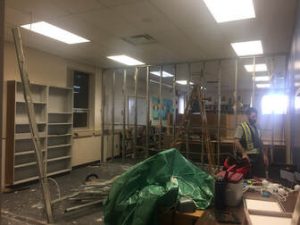
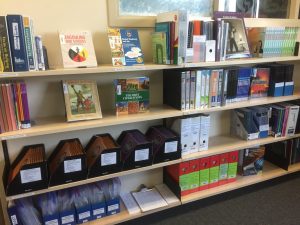
Beyond the actual physical space we have a digital presence. We try and keep our blog updated with what is going on in the Learning Commons, so even if students can’t make it into the space they are still connected. They are also able to put holds on books through the LLC and we deliver them to their classrooms. This was a lifesaver during Covid. We also are in constant communication with the school community because we are in charge of booking all of the laptop and iPad carts for the school and to help with any tech related problems.
The actual physical space is also very inclusive. We have selected a wide range of books and are constantly updating them so every child can see themselves in the collection. We want to make the space as inclusive as possible and are always seeking new ways to do this. Whether it’s through the books, posters or even diming the lights or sounds if some students have sensory issues.

Like this module 4 iterated, participatory culture in schools is constructed. The LLC needs to be set up so that inquiry is possible and student’s and teachers are successful. Jenkins (2006) identified five aspects of participatory culture. I especially felt strongly about his first point, “ Students feel they can express themselves creatively and be engaged in the way it provides resources, services, and support.”
I feel like my LLC is “lucky” in that we have a full time clerk and a very supportive admin and PAC. I know that we are an exception. So many schools in BC and across the world for that matter, do not have the resources or support that is required to give students the tools they need to thrive. I hope that it will get better but am unsure if much will change.
Next, I considered one barrier to collaboration for our learning commons. I think the biggest issue is time. Teachers are so over worked and stressed, especially through the pandemic. Time is very limited as it is and I think some teachers are reluctant to collaborate because they are just trying to get through the day. Although, this year seems to be a lit bit better in terms of time teachers are still scrambling, constantly trying to figure out how to fit as much curriculum as they can and never feel like they have enough time. Nobody has wanted to work toward developing anything “new”. As suggested by Fontichiaro and Oehrli’s “Lesson #4: Take Something Off the Other Person’s Plate” (p. 38), I may try to lessen their load and offer to teach for them. I think if teachers will be more willing to collaborate, or bring their kids into the library if I take the initiative. Another idea I had was to have a meeting with teachers and ask what they would like me to teach. I think this needs to be done at the beginning of the year. Once the year is in full swing it is harder to get teachers to change their habits.
References:
Fontichiaro, K. & Oehrli, J. A. (2014a). Nudging toward inquiry – Turning the tables on collaboration part I: Planning for success.Library Media Connection 32(4): 36-38.
Hamilton, B.J. (2011a). Creating conversations for learning: School libraries as sites of participatory culture. School Library Monthy 27(8):41-43.
Part two: How the integration or embrace of Indigenous ways of knowing into teaching practice can enable learning to be accessible for all students.
By integrating and embracing Indigenous ways of knowing into our teaching practice, we can enable learning and accessibility for all students. Inquiry learning and Indigenous ways of knowing have a lot of similar parallels. Teachers can use Indigenous ways of knowing in their every day teaching practice that will help all of their students.
Teachers are finally being trained to address all of their learners unique learning styles as well as, their cultural heritage, when they develop plans for lessons. Resources like, The Aboriginal Lens – Education for Reconciliation (2017) developed by the BC Teachers’ Federation are helpful tools to use when planning lessons or units. This framework is designed to help teachers challenge the current, established systems of belief that support Eurocentric practices that have historically silenced other ways of knowing and being. The lens focuses efforts and can be used to examine and assess policies and practices. The framework also works to address the needs of the collective and the community, as well as providing teachers and students a reference guide. All of the points laid out in the document are straight forward and demonstrate how they are important for both students and teachers to use. Reconciliation takes the work of everyone in our community and country. All students will benefit from participating.
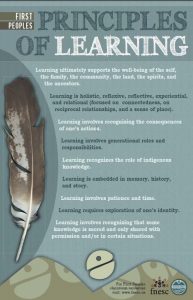
I like to use the First Nations Principles of Learning (2020) as a reference in my classroom. I think the points laid out in it are very straightforward for teachers and students to use. I also think each point is very connected to inquiry learning. For example, “Learning requires exploration of one’s identity,” this point is also true for inquiry. Students learn based on their own identity. It is also crucial for teachers to understand students, their identity, their likes and preferences in order for them to design lessons and units for them to learn. Another principles states, “ Learning involves patience and time” again the same can be said for inquiry learning. Students learn when they are ready to. Inquiry learning recognizes that not all students learn at the same time the same way that Indigenous ways of knowing does. This principle directly enables learners and makes learning accessible because it recognizes the learner as an individual much like inquiry learning does. The First Nations Principles of Learning are very much aligned with inquiry learning and when used consistently will help all learners in the classroom.
Kathy Sandford, Lorna Williams, Tim Hopper, and Catherine McGregor (2012), in their work Indigenous Principles Decolonizing Teacher Education: What We Have Learned, lay out the differences between traditional learning in schools and traditional learning in indigenous communities. The points laid out by the authors above point out Indigenous “ways of knowing” and are consistent with that of inquiry-based learning:
- Learning is emergent
- Focus on students and teacher interaction
- Learning happens in many locations, inside and outside the school; classroom can be noisy
- Students construct knowledge through gathering and synthesizing information
- Students work in pairs, groups, or alone depending on the purpose of the activity
- Assessment is used in context to promote and diagnose learning
- Learners are guided to find their own solutions and answer their own questions
- Students evaluate their own learning; teachers also evaluate; teaching and assessing are intertwined
- Students have multiple opportunities for success and quiet recognition
- Students have some choice of learning activities and topics
- Approach is compatible with multi- and inter-disciplinary investigation
These points are interchangeable with inquiry learning. Teachers sometimes get overwhelmed thinking that using Indigenous ways of knowing is like adding another component to their already overwhelming teaching load. When in fact, many times it is something they are already doing, like when using inquiry based methods of learning. I think it is still important for teachers and students to be cognizant of Indigenous ways of learning. However, one does not have to ‘reinvent the wheel’ in order to do so.
While our country works through its horrible history and the devastating impacts felt from residential schools and the Truth and Reconciliation act, teachers must recognize Indigenous ways of knowing. By using First Nations Principles of learning, and working through decolonizing the curriculum we are enabling ALL students to learn. Inquiry learning and Indigenous ways of knowing do not mean ‘more work’ for students and teachers. Many instances it is something we are already doing. However, we need to be aware of this important way of knowing and learning and recognize its importance. Teachers and students who are non-Indigenous benefit immensely from Indigenous ways of knowing. We are also responsible for ourselves and our role in Truth and Reconciliation.
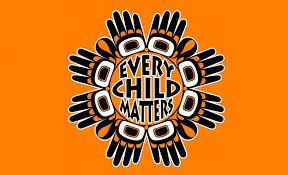
References:
BC Teachers’ Federation. (2017). The Aboriginal lens: Education for reconciliation. In Aboriginal Education. Vancouver, BC: BCTF.
First Peoples Principles of Learning. (2020, September 14). Retrieved October 10, 2021, from http://www.fnesc.ca/first-peoples-principles-of-learning/
View of Indigenous Principles Decolonizing Teacher Education: What We Have Learned: In education. (n.d.). Retrieved October 10, 2021, from https://ineducation.ca/ineducation/article/view/61/547
